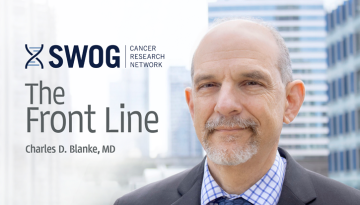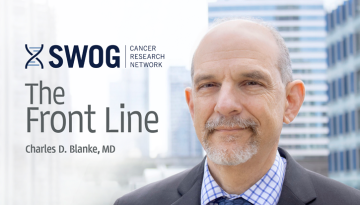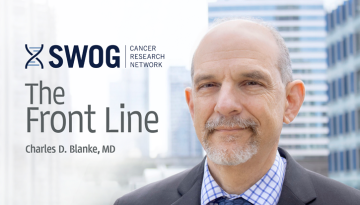Biospecimen Quality: Protecting the Value of Our Biobank Currency
Last fall I wrote in this space about SWOG's rich set of biobank resources, most of which reside within the SWOG Biospecimen Bank at Nationwide Children's Hospital.
Getting maximum value from these resources does first require that the specimens submitted to the Bank be of consistently high quality – that they comply with all requirements for labeling, collection, processing, storage, documentation, and shipping.
Almost one-fifth of specimens submitted from SWOG sites, however, fall short in some way. Perhaps surprisingly, most often the problem is with the data – information on the specimen label or in the accompanying documentation is missing, incomplete, or inconsistent.
While these data errors often can be clarified or corrected so that the specimens can still be used for research, doing so requires significant added effort by both site and Bank staff.
Other common issues that can affect a specimen’s quality (and ultimately determine whether it can be used for research) include
- an expired or incorrect collection tube
- insufficient packaging to maintain specimen temperature during shipping (example: a frozen specimen that arrives thawed because not enough dry ice was packed around it)
- inadequate specimen volume or quantity
To help reduce the rate of problematic submissions and make it easier for sites to submit specimens correctly, we’ve created some new resources sites can use to provide clear guidance to staff who collect, process, and ship specimens.
These guidelines – developed based on input from members at many sites – highlight the most important factors in collecting and submitting high-quality specimens. The guidelines have been formatted to be scannable, searchable, and easily digestible, with much information presented in tables or lists, so staff can quickly find what they need.
Content is broken out by topic into pages that can be printed and used in different areas at your site. All of these guidelines are available as PDFs, so you can print them, laminate them or put them in a binder, and have your own copy of a SWOG specimen manual, with the latest PDF version always available at the evergreen URL https://swog.org/CompleteSpecimenGuide.
The new resources are under the Clinical Trials menu in swog.org. The former “Biospecimen Resources” menu item there has been split into two: Biospecimen Submission (deposits) and Biospecimen Access (withdrawals).
Biospecimen Submission provides guidance on labeling, collecting, processing, documenting, tracking, packaging, and shipping specimens that are part of SWOG trials. The top-level page includes a brief reminder of the problems the Bank sees most often:
- incomplete or inaccurate labeling of a specimen
- mismatches between the information on the specimen label and what’s recorded in the Specimen Tracking System (STS)
- lack of supporting documentation, such as a missing STS packing list or pathology report (required with tissue specimens)
Below the top-level page, the guidelines are broken out into four main sections:
- labeling specimens
- collecting and processing specimens
- tracking and documentation
- packaging and submitting
As specimen labeling issues are the most common, we’ve provided easy-to-print label templates for five types of specimens, now available in both MS Word and PDF formats that you can print – pre-completed or blank – on a standard sheet of address labels (Avery 5160, to be precise). The label templates make it easier to know what must be recorded on a specimen and in what format, reducing the chances something will be missed.
These website materials provide general specimen guidelines. The cardinal rule is to always check the protocol first, as that will give you the what, when, and how answers you need for the given trial. We’ll continue to update these materials and to add new resources as needed. We welcome and encourage your feedback (via email to training@swog.org) to help us improve these guidelines.
We’re also revising the SWOG protocol template to ensure all newly activated protocols that involve specimen collection include standardized tables that clearly outline the trial’s specimen collection and submission expectations.
I want to thank the members of our quality initiative working group for addressing this issue, as well as the team that developed the new set of guidelines, which includes staff from the SWOG Biospecimen Bank and from SWOG’s statistical, data management, protocols, training, and quality assurance offices.
Everyone worked hard to deploy these resources before group meeting, so they could be referred to in several talks on specimen quality, impact, and submission and access processes. Recordings of those talks are now posted to SWOG’s ExpertusOne learning management system, and I link to them below. Site staff who missed a presentation in Seattle or who are new to their role can view the recordings (member login required) and then print a completion certificate to document that training locally.
- Clinical Trials Training Course (a valuable training opportunity for all new oncology research professional [ORP] staff, held at group meeting each spring)
- Specimen Tracking System – by Matt Gospe, BS, SWOG Statistics and Data Management Center (SDMC)
- Tips for Specimen Submission to the SWOG Biospecimen Bank – by Kae Tegtmeier, BS, SWOG Biospecimen Bank at Nationwide Children’s Hospital
- Jeri and Noboru Oishi Symposium (our ORP committee once again did a fabulous job with this event this spring)
- SWOG Biospecimens: Quality, Compliance, and Tips and Tricks – by Phyllis Goodman, MS, SWOG SDMC (includes a highly informative discussion of why and how specimen collection has become an ever more important component of our clinical trials)
- Improving Specimen Submissions to SWOG Biospecimen Bank – by Kae Tegtmeier, BS, SWOG Biospecimen Bank at Nationwide Children’s Hospital
- Translational Medicine Plenary – Plenary I (the TM plenary this spring included a mini-symposium on the NCTN BioBank Navigator with the following two presentations)
- NCTN Navigator Lessons Learned – by Yvonne Moyer, MBA, SWOG Biospecimen Bank at Nationwide Children’s Hospital
- The Future of Navigator and Tissue Acquisition – by Grace Mishkin, PhD, MPH, National Cancer Institute
(Recordings of these and other open sessions from the spring group meeting are also now linked for member access from the SWOG website.)
I’ll close with a quote from Joyce Nancarrow Tull, MSN, RN, one of the planners of this spring’s Oishi Symposium. In introducing Phyllis and Kae at that event, Joyce said, “Blood and the specimens from our patients are the currency of cancer. … they buy all the answers. They tell us where the secrets are.” I couldn’t have said it better myself. Maintaining maximum value of such currency has to be a priority for all of us.
Other Recent Stories



